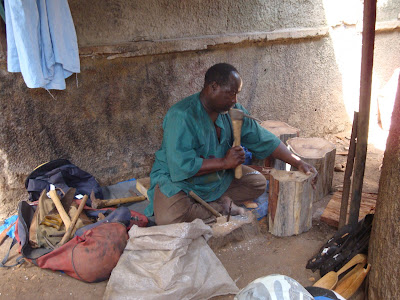The men in the background are the taxi drivers.

Even the dog has a necklace! The shell on the necklace is like the ones that were once used as Senegalese currency.

This drink seller was on the same street.

Tidiane was telling Sharron that prices here were too high. (The vendors see Americans and their prices go up by about 5X!) When Sharron stepped into a store, 5 or 6 people inside began telling her not to listen to the other sales people and to buy from them. They insisted the other salespeople were dishonest. When she left the store, they followed her into the next store, still trying to make a sale. It is so hard to concentrate on what you want to buy when so many people are vying loudly for your attention! Frustrated by the pursuit, we left the market area with very few purchases. Americans destroy the peace of the markets; it seemed vendors pushed and shoved so hard for business that we feared fights would break out.

We also went to an area where wood carvers work. It was fascinating to see how they did the carving by hand with very primitive tools and to see all of the products. One man splits the raw wood into smaller pieces to be worked by the other carvers.

Hatchets, gouges, hand saws and sandpaper turn out products that are amazing and beautiful. The carvers seem to work tirelessly in their seated positions that are flat on the floor. As we look at their products, the salesmen are relentless; they yell, "Hey Mama, Hey Papa" to barter and beg you to buy.





















































